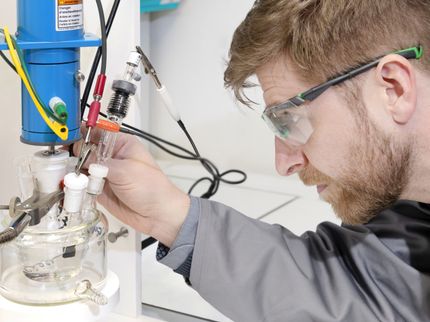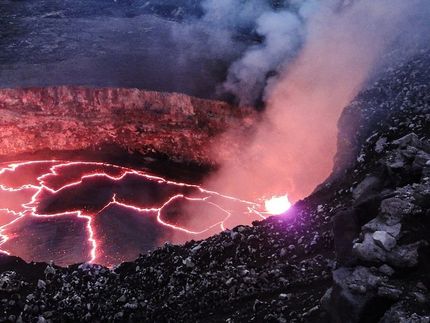Biomass production by reverse citric acid cycle
Central metabolic pathway runs "backwards" at high carbon dioxide concentrations
Advertisement
A research team from the University of Münster and the Technical University of Munich (TUM) has gained new insights into the citric acid cycle: At very high carbon dioxide concentrations, bacteria can also use this central metabolic pathway "backwards" to build useful compounds from carbon dioxide using the enzyme citrate synthase. It is possible that these findings can also be used biotechnologically.

Co-author Thomas M. Steiner and the gas chromatograph with coupled mass spectrometer, with which he analyzed the metabolic products.
Thomas Geisberger / TUM
The citric acid cycle is an important metabolic pathway that enables living organisms – from simple bacteria to humans – to generate energy by degrading organic compounds into carbon dioxide (CO₂). The first step in the cycle is usually performed by the enzyme citrate synthase, which builds citrate.
But, under anaerobic conditions, in the absence of oxygen, some bacteria can perform the cycle in reverse order: They can build up biomass from CO₂. In this so-called reversed citric acid cycle, citrate synthase is replaced by ATP-citrate lyase, which consumes cells’ universal energy carrier adenosine triphosphate (ATP) to cleave citrate instead of forming it.
However, a few years ago, a research team led by Ivan Berg (University of Münster) and Wolfgang Eisenreich (Technical University of Munich) discovered that instead of requiring ATP-citrate lyase for the reversed cycle, some anaerobic bacteria can use citrate synthase itself to catalyze citrate cleavage – without consuming ATP.
What determines the direction of the citric acid cycle?
For their newest work, now published in the journal Nature, the researchers studied the anaerobic bacteria Hippea maritima and Desulfurella acetivorans. These organisms live without oxygen at hot springs, where the CO2 concentration can be 90 percent and higher.
A main question of their current research was, what factor determines whether the citric acid cycle runs “forwards” or “backwards” in the bacteria. Cultivating the bacteria under different conditions, they noticed that the growth of these organisms was highly dependent on the CO₂ concentration in the gas phase.
The studied Hippea maritima and Desulfurella acetivorans were able to grow very well at 20% and 40% CO₂ in the gas phase but only moderately at 5% CO₂, and no growth was possible at 2% or 1% CO₂. As a control, the scientists studied another autotrophic bacterium Desulfobacter hydrogenophilus, which uses the energetically more expensive ATP-citrate lyase version of the reversed citric acid cycle. In this bacterium, growth was not affected by the CO₂ concentration.
The high CO₂ concentration was needed to allow the function of another important enzyme, pyruvate synthase. This enzyme is responsible for assembling acetyl coenzyme A (acetyl-CoA), the product of the "reversed cycle". The high CO₂ concentration drives the pyruvate synthase reaction in the direction of carboxylation and the entire cycle backwards, enabling CO₂ to be converted into biomass.
Fast switching without gene regulation
The “backward cycle” that uses citrate synthase for citrate cleavage cannot be bioinformatically predicted, as it does not have the key enzymes whose presence can be used as a marker for the functioning of the pathway. Therefore, as an identifying feature for bioinformatic analyzes, the scientists used the detected high levels of citrate synthase in these bacteria’s protein cocktail.
Using a special analysis tool, the researchers were able to predict the production levels of individual proteins. With this trick, it was possible to predict the functioning of the “backward cycle” for inorganic carbon fixation in many anaerobic bacteria.
The scientists also showed that no gene regulation was necessary for switching from the oxidative (“forward”) to the reductive (“reverse”) direction. “This means that the cells can react very quickly on the availability of the carbon source in the environment” says Ivan Berg. "They use either the reductive direction to fix CO₂, if the concentration of CO₂ is high, or the oxidative direction, if another carbon source is available."
Reverse citric acid cycle more common than expected
"It is conceivable that many other organisms use this cycle to bind CO₂," says Ivan Berg. “Our findings are in line with the results of several recent studies highlighting a potential widespread occurrence of this reversed oxidative citric acid cycle.”
The researchers assume that such CO₂ concentration-dependent pathways could have been widespread on the primordial earth, since the CO₂ concentration was high at the time. Therefore, this metabolic pathway may be a relic of early life.
Alternatively to the newly discovered route of the reverse citric acid cycle via the citrate synthase, many bacteria use the energetically less efficient route through the ATP-consuming citrate lyase reaction for citrate cleavage.
“It was mysterious why this 'expensive' version of the pathway exists if an energetically much cheaper alternative through the backwards reaction of citrate synthase is feasible. Now we know that this is due to the low CO₂ concentrations in many environments. The cheap alternative doesn't work there.” emphasizes Wolfgang Eisenreich.
These findings could also be of interest for biotechnology. With the knowledge that autotrophic organisms using this "backward cycle" depend on the CO₂ concentration, scientists can apply it to more efficiently convert substrates into value-added products.



















































